
AI Content Creation
Create a Kids Cartoon with AI: A Complete Guide for 2025

Contents
- 1 Why Use AI to Create a Kids Cartoon?
- 2 Benefits of AI in Kids Cartoon Production
- 3 Tools You Can Use to Create a Kids Cartoon with AI
- 4 Step-by-Step Process to Create a Kids Cartoon with AI
- 5 Best Practices for Kid-Friendly AI Cartoons
- 6 Common Challenges and How to Solve Them
- 7 Tips to Add Educational Value to AI Cartoons
- 7.1 1. Align Content with Learning Objectives
- 7.2 2. Introduce Repetition with Purpose
- 7.3 3. Include Call-and-Response Prompts
- 7.4 4. Use Visual Cues and On-Screen Text
- 7.5 5. Embed Problem-Solving Scenarios
- 7.6 6. Include Positive Behavioral Modeling
- 7.7 7. Support Multisensory Learning
- 7.8 8. Test with Educators and Parents
- 8 Case Studies: AI-Generated Kids Cartoons in Action
- 9 The Future of AI in Children’s Animation
In today’s digital age, learning how to create a kids cartoon with AI has become easier, faster, and more accessible than ever before. Whether you’re an educator, content creator, or parent with a great story idea, AI-powered tools can help you bring your vision to life with minimal resources and maximum creativity. From scripting and voiceovers to animation and editing, artificial intelligence handles it all—often in just a few clicks.
As the demand for fun and educational kids’ content continues to rise, using AI for cartoon creation offers a smart solution for anyone looking to entertain and teach young audiences. This guide will walk you through everything you need to know, including the best tools, step-by-step process, and practical tips to successfully create your own kids cartoon with AI. Let’s dive in!
Why Use AI to Create a Kids Cartoon?
Creating animated content traditionally requires a team of artists, animators, scriptwriters, and sound designers. However, when you create a kids cartoon with AI, you simplify the entire process dramatically. Artificial intelligence empowers creators to generate professional-quality cartoons quickly, without the need for expensive software or specialized skills.
One of the main reasons to use AI is efficiency. AI tools can automatically generate character designs, animate scenes, write scripts, and even provide lifelike voiceovers—all in a fraction of the time it would take a human team. As a result, what once took weeks or months can now be done in hours.
Additionally, AI makes content creation accessible to more people. Educators can produce custom educational videos for their classrooms, parents can bring bedtime stories to life, and small content creators can launch full cartoon series—all without hiring large production teams.
Furthermore, AI allows for creative experimentation. You can test different styles, characters, or storylines instantly and revise them as needed. This level of flexibility is especially important when producing content for children, where attention spans are short and engagement is key.
In short, using AI to create a kids cartoon offers a modern, cost-effective, and scalable way to deliver entertaining and meaningful content to young audiences.
Benefits of AI in Kids Cartoon Production
When you decide to create a kids cartoon with AI, you unlock a wide range of benefits that streamline production, boost creativity, and enhance viewer engagement. Below are some of the key advantages that make AI an ideal partner in the world of children’s animation:
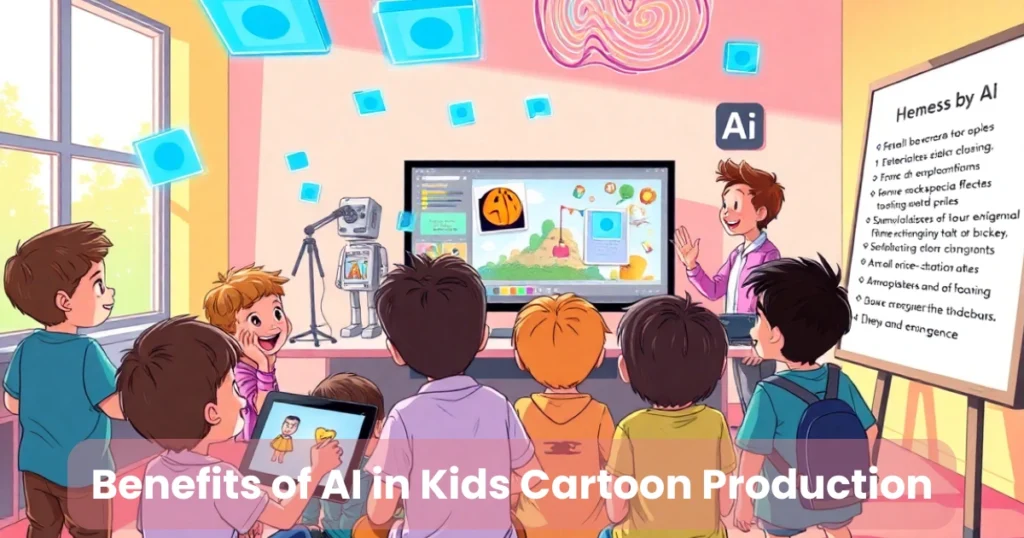
1. Faster Production Time
AI significantly reduces the time needed to go from concept to final video. Tools can generate character animations, voiceovers, backgrounds, and even storyboards within minutes. This rapid turnaround means you can release more content in less time.
2. Budget-Friendly Solution
Traditional animation can be costly, especially when hiring teams for scriptwriting, voice acting, and design. AI tools allow you to create a kids cartoon with AI at a fraction of the cost, making high-quality production accessible to individuals and small teams.
3. User-Friendly for Non-Experts
You don’t need to be a professional animator or coder to use AI animation tools. Most platforms are designed with simple interfaces, drag-and-drop features, and ready-made templates—perfect for educators, parents, and beginners.
4. Customization and Personalization
AI lets you tailor characters, voices, and scenes to suit your specific goals. Whether you’re making an educational cartoon or telling a bedtime story, you can easily personalize the content to appeal to different age groups and learning styles.
5. Multilingual Capabilities
Want to reach kids worldwide? Many AI tools offer automatic translation and voice dubbing, allowing you to produce cartoons in multiple languages effortlessly. This makes your content inclusive and globally scalable.
6. Consistency in Quality
AI ensures uniformity in animation quality, voice tone, and visual style across episodes or series. This consistency helps build brand identity and keeps young viewers engaged.
By leveraging these benefits, you can create a kids cartoon with AI that is not only creative and fun but also efficient, cost-effective, and scalable. In the next section, we’ll explore the best AI tools to help you get started.
Tools You Can Use to Create a Kids Cartoon with AI
To successfully create a kids cartoon with AI, you need the right set of tools that handle everything from writing scripts to animating characters and generating voiceovers. Thankfully, several AI-powered platforms make the cartoon creation process intuitive and efficient—even for beginners. Below are some of the top tools to consider in 2025:

1. Toonify.ai
Best for: Character creation
Toonify uses AI to transform real photos or sketches into cartoon-style characters. It’s perfect for quickly generating unique and child-friendly avatars that you can use throughout your cartoon series.
2. Animaker
Best for: Complete animation production
Animaker offers drag-and-drop functionality with pre-made characters, backgrounds, and transitions. It’s a great option to create a kids cartoon with AI without needing prior animation experience.
3. Pictory.ai
Best for: Turning scripts or stories into animated videos
Pictory allows users to input a written script or upload a video, which it then turns into animated content complete with AI voiceovers and music. Ideal for educational cartoons and storytime animations.
4. DeepBrain AI
Best for: AI voice generation and avatars
DeepBrain AI offers human-like voice synthesis and video avatars that can narrate your cartoon, adding personality and emotion that resonate with young viewers.
5. Runway ML
Best for: AI-powered video editing and effects
If you want more advanced editing features, Runway ML gives you access to AI tools for rotoscoping, motion tracking, and real-time style transfer—all useful in polishing your cartoon’s visual appeal.
6. Synthesia
Best for: Multilingual cartoons and storytelling
Synthesia allows you to generate AI avatars that can speak in over 120 languages. This is especially useful if you plan to distribute your cartoon to global audiences or create multilingual versions.
7. Storyboard That
Best for: Pre-visualizing scenes
Before animating, you can sketch out your cartoon’s flow with Storyboard That. It helps you organize scenes, dialogue, and character placement, ensuring a smooth production process.
By using these tools, you can efficiently create a kids cartoon with AI that is entertaining, educational, and customized for your audience. Next, we’ll walk through a step-by-step process to bring your AI-powered cartoon to life.
Step-by-Step Process to Create a Kids Cartoon with AI
Now that you understand the benefits and tools available, it’s time to walk through the exact steps you need to follow to create a kids cartoon with AI from start to finish. Whether you’re a beginner or an experienced creator, this step-by-step process will simplify your journey.
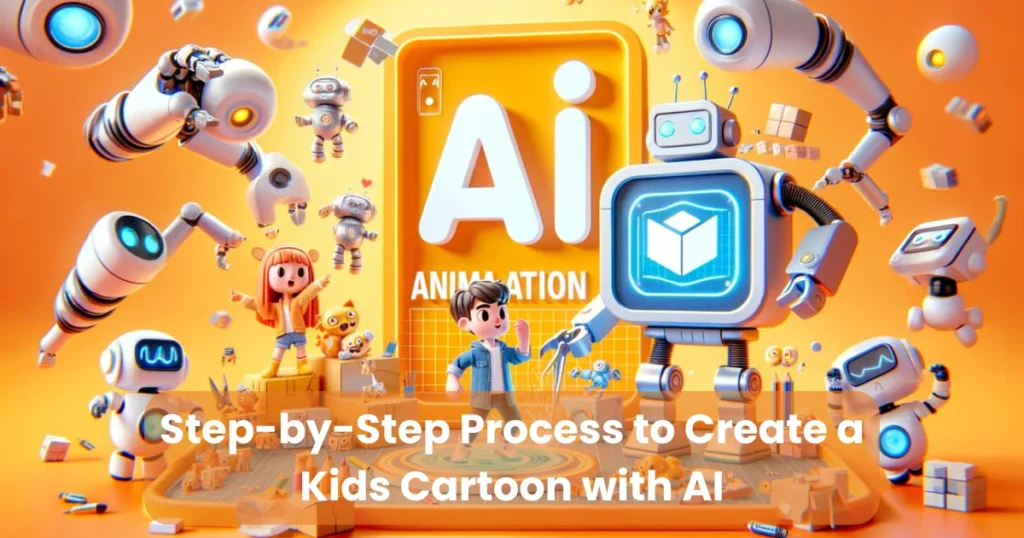
Step 1: Define Your Concept and Target Age Group
Start by deciding on the theme, purpose, and age group for your cartoon. Is it educational, entertaining, or both? Tailor the tone, characters, and story length accordingly. For preschoolers, keep stories simple and visuals bright. For older kids, you can include more dialogue and complexity.
Step 2: Write a Simple Script
Use AI writing tools like ChatGPT or Copy.ai to generate a child-friendly script. Make sure the dialogue is easy to understand, positive in tone, and includes repetition or rhymes to help with learning and retention.
Step 3: Choose or Generate Characters
To create a kids cartoon with AI, character design is key. Use Toonify, Animaker, or Ready Player Me to design cute, expressive characters. Make sure they are colorful, relatable, and consistent throughout the series.
Step 4: Create Voiceovers with AI
Next, bring your script to life using AI-generated voices from platforms like Murf.ai, WellSaid Labs, or LOVO.ai. Choose child-appropriate, cheerful voice styles to maintain engagement. You can also generate character-specific voices for a more dynamic experience.
Step 5: Animate Your Cartoon
Import your characters and script into animation platforms such as Animaker, Vyond, or Renderforest. Drag-and-drop scenes, add animations, and sync voiceovers with character actions. Most tools allow you to animate without any coding knowledge.
Step 6: Add Music and Sound Effects
Use royalty-free AI music tools like Soundraw.io or AIVA to add background music that fits your cartoon’s mood. Don’t forget playful sound effects for movement, actions, and emotional cues—it keeps kids engaged and entertained.
Step 7: Edit and Preview
Use platforms like Runway ML or Pictory for quick video editing. Review your cartoon thoroughly to fix sync issues, audio mismatches, or visual glitches. Preview it with your target audience (kids or parents) for feedback.
Step 8: Export and Publish
Once finalized, export your cartoon in HD format. You can publish it on YouTube Kids, educational platforms, or your own website. Include subtitles or voiceovers in multiple languages if you want to reach a broader audience.
By following this process, you can create a kids cartoon with AI that’s engaging, professional-looking, and packed with educational or entertainment value—without spending weeks in production.
Best Practices for Kid-Friendly AI Cartoons
When you create a kids cartoon with AI, it’s not just about technology—it’s about crafting content that’s safe, meaningful, and enjoyable for children. Following best practices ensures that your cartoon is age-appropriate, engaging, and impactful. Below are the key principles to keep in mind:
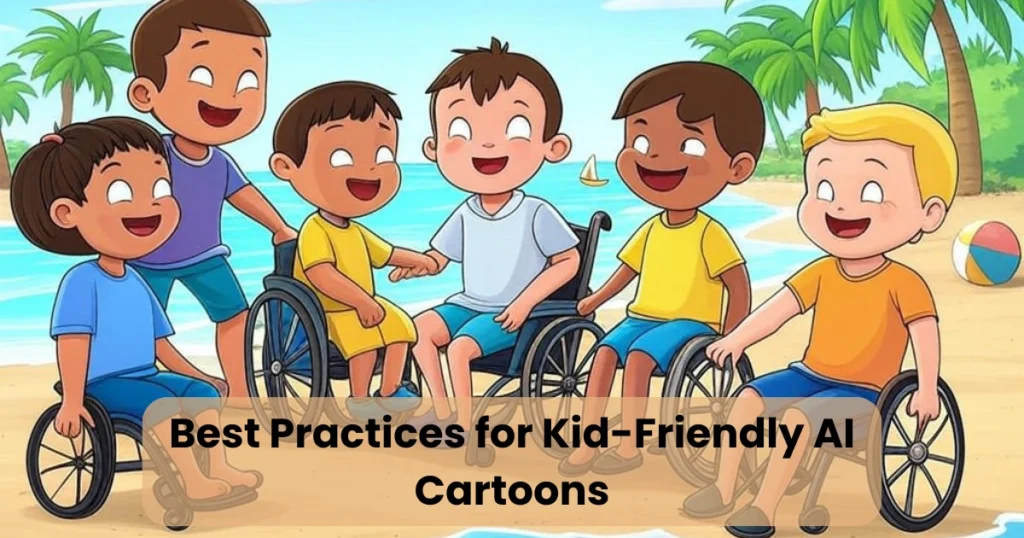
1. Keep It Simple and Positive
Young children respond best to clear messages, simple language, and optimistic stories. Avoid complex plots or mature themes. Focus on clear character motivations, happy resolutions, and easy-to-follow storylines.
2. Use Bright Colors and Soft Shapes
Visually, children are drawn to vibrant, saturated colors and round, friendly shapes. When you create a kids cartoon with AI, choose visual elements that are visually stimulating but not overwhelming. Avoid harsh lines or dark, muted palettes.
3. Maintain a Friendly and Safe Tone
Your cartoon should reflect kindness, cooperation, and empathy. Make sure characters model good behavior—like sharing, being honest, and helping others. Avoid violence, sarcasm, or anything that could cause confusion or fear in younger audiences.
4. Limit Screen Time and Episode Length
Children, especially toddlers and preschoolers, benefit from shorter episodes. Aim for 2 to 7 minutes per episode. If your cartoon is educational, include interactive breaks or questions to reinforce learning.
5. Use Repetition for Learning
Repetition helps with memory and language development. Repeat phrases, melodies, or actions to reinforce key lessons or vocabulary. Many AI tools allow you to easily duplicate scenes and audio clips for this purpose.
6. Include Subtle Learning Elements
Even entertainment-focused cartoons can teach. Use colors, numbers, shapes, or moral lessons subtly woven into the storyline. You can also align your cartoon with educational standards by working with AI content planners or curriculum generators.
7. Ensure Accessibility
When you create a kids cartoon with AI, consider adding subtitles, sign language avatars, or multiple language options to make your content inclusive. Use clear fonts and avoid fast transitions that may overwhelm children with sensory sensitivities.
8. Test with Real Kids and Parents
Always preview your cartoon with your target audience before publishing. Gather feedback on clarity, enjoyment, and length. What adults assume children will like doesn’t always match reality—testing helps you improve and connect more effectively.
By following these best practices, your journey to create a kids cartoon with AI becomes more than just animation—it becomes a tool to inspire, teach, and delight young minds in a responsible and engaging way.
Common Challenges and How to Solve Them
While it’s easier than ever to create a kids cartoon with AI, the process isn’t without its challenges. From technical limitations to creative roadblocks, certain issues can slow down production or affect content quality. Below are the most common problems creators face—and how to solve them efficiently.
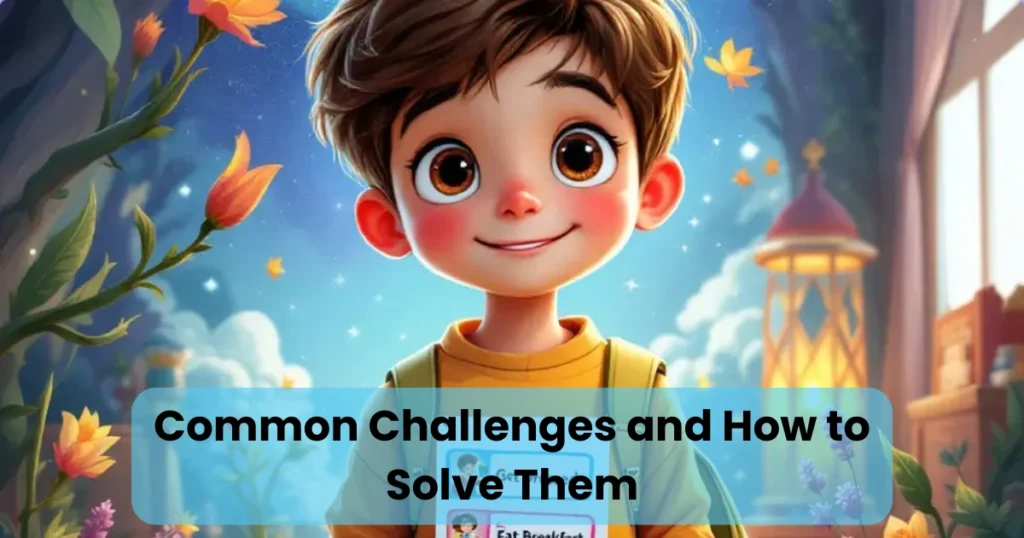
1. Limited Creativity in AI-Generated Scripts
The Challenge:
AI tools can sometimes generate bland or repetitive storylines that lack emotional depth or humor—both essential for kids’ engagement.
The Solution:
Use AI as a starting point, not a final draft. Enhance the script manually by adding unique dialogue, fun wordplay, or personal touches. You can also use AI tools like ChatGPT with specific prompts to tailor creativity for children’s content.
2. Robotic or Unnatural Voiceovers
The Challenge:
Some AI-generated voices still sound stiff or emotionless, making it harder for kids to connect with the characters.
The Solution:
Select tools that offer emotional tone options like Murf.ai or WellSaid Labs, and preview several voice styles. Pair expressive voices with engaging background music and sound effects to bring scenes to life.
3. Character Rigidity or Awkward Animation
The Challenge:
When you create a kids cartoon with AI, certain animation tools may produce robotic or repetitive movements that reduce viewer immersion.
The Solution:
Choose AI animation platforms with motion customization and scene flexibility, such as Animaker or Vyond. Add subtle gestures and facial expressions to make characters more dynamic and relatable.
4. Lack of Cultural Sensitivity or Age Appropriateness
The Challenge:
AI doesn’t always understand cultural nuances or age-specific sensitivities, which can lead to inappropriate or confusing scenes.
The Solution:
Always review scripts and animations manually. Involve educators or parents in the feedback loop, and use tools with built-in filters for age-appropriate content creation.
5. Overuse of Generic Visuals
The Challenge:
Some platforms reuse templates and characters frequently, which may make your cartoon feel generic or repetitive.
The Solution:
Customize your visuals using advanced settings or integrate AI character design tools like Toonify or Ready Player Me. Originality can be the key differentiator in children’s content.
6. Technical Learning Curve
The Challenge:
Although tools are beginner-friendly, first-time users may still find it overwhelming to manage multiple platforms for scriptwriting, animation, and audio.
The Solution:
Start small. Use all-in-one platforms like Renderforest or Pictory that combine multiple steps in one workflow. As you grow more confident, integrate more specialized tools.
By anticipating these obstacles, you can plan smarter and create a kids cartoon with AI that’s polished, entertaining, and impactful—while avoiding common pitfalls that frustrate new creators.
Tips to Add Educational Value to AI Cartoons
If you plan to create a kids cartoon with AI, it’s a great opportunity not only to entertain but also to educate. Children learn best through stories, visuals, and repetition—all strengths of animated content. By thoughtfully integrating educational elements, you can help kids build language, emotional intelligence, math skills, and more. Here’s how to do it effectively:
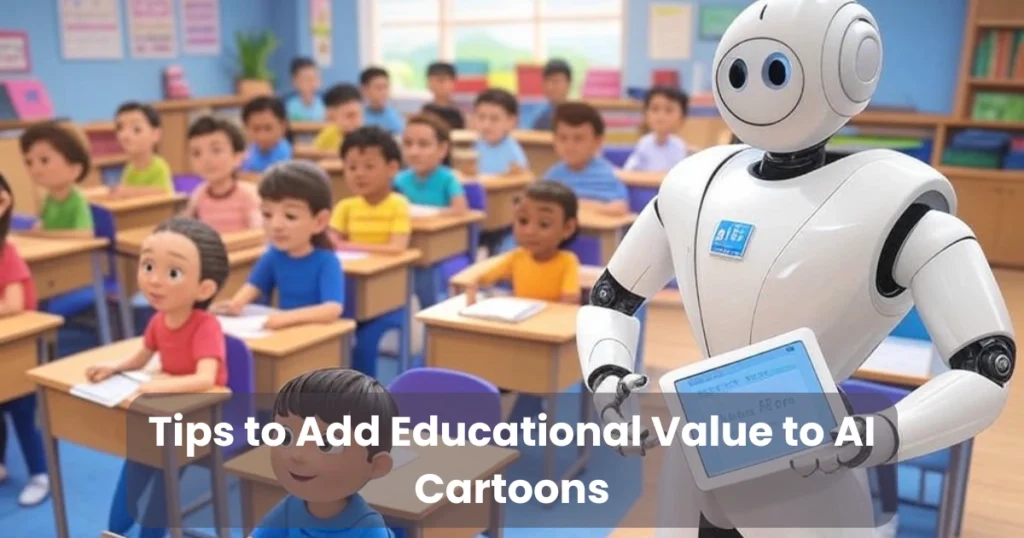
1. Align Content with Learning Objectives
Start by identifying the specific skills or knowledge you want children to gain. Whether it’s counting, colors, emotional awareness, or simple science facts, structure your cartoon around those goals. AI scriptwriting tools like ChatGPT can generate age-appropriate dialogue aligned with common educational frameworks.
2. Introduce Repetition with Purpose
Repetition is a powerful tool in early learning. Use repeated phrases, songs, or actions to reinforce key concepts. When you create a kids cartoon with AI, make sure your storyline includes natural opportunities to revisit ideas—like numbers, vocabulary, or character values.
3. Include Call-and-Response Prompts
Encourage kids to engage by pausing the video for questions or prompts. For example: “Can you find the red balloon?” or “Let’s count together!” AI tools like Animaker allow you to build in these breaks easily to boost interactivity.
4. Use Visual Cues and On-Screen Text
Highlight words, numbers, or concepts visually as they’re spoken. Displaying “apple” on-screen as the character says it helps with reading development. You can use AI tools like Pictory or Runway ML to automate the addition of text overlays and motion graphics.
5. Embed Problem-Solving Scenarios
Create simple challenges in the storyline that characters solve using logic, teamwork, or reasoning. For example, a character might figure out how to share a toy or how many steps it takes to cross a bridge. These micro-moments teach critical thinking in a relatable way.
6. Include Positive Behavioral Modeling
Use characters to model behaviors like saying “please,” taking turns, apologizing, and expressing feelings. When you create a kids cartoon with AI, emotional intelligence and social learning are just as important as academic topics.
7. Support Multisensory Learning
Combine audio (songs, dialogue), visual (colors, shapes), and kinesthetic cues (actions or movement). AI-generated music and animations can help reinforce messages in a memorable, multi-sensory way.
8. Test with Educators and Parents
Before finalizing your cartoon, share it with teachers, child psychologists, or parents. Their feedback ensures your content is age-appropriate, engaging, and educationally sound. You can also use AI surveys or feedback tools to streamline the process.
By applying these tips, you can create a kids cartoon with AI that entertains while actively contributing to a child’s cognitive, emotional, and social development—making your cartoon both fun and functional.
Case Studies: AI-Generated Kids Cartoons in Action
As more creators embrace the opportunity to create a kids cartoon with AI, real-world success stories are emerging that highlight both the creative potential and educational impact of AI-driven content. Below are several case studies that demonstrate how individuals and small teams have leveraged AI to produce engaging, high-quality cartoons for children.
1. “Luna Learns” – A One-Person Educational Series
Creator: Sarah M., a former kindergarten teacher
AI Tools Used: ChatGPT (scriptwriting), Animaker (animation), Murf.ai (voiceovers), Soundraw (music)
Overview:
Sarah wanted to teach basic science concepts through short, animated stories. With no background in animation, she used AI tools to produce “Luna Learns,” a colorful series following a curious bunny exploring the world. Each episode runs under 5 minutes and focuses on a single concept, like how rain is formed or why the moon changes shape.
Result:
The series gained over 50,000 views on YouTube Kids in just three months and is now used by homeschooling communities and teachers.
2. “Toto’s Time Adventures” – A Father’s Weekend Project
Creator: James R., a full-time software developer
AI Tools Used: Runway ML (video editing), Synthesia (AI avatars), DeepBrain AI (voice cloning)
Overview:
Looking for a fun way to bond with his daughter, James began creating episodes about a time-traveling cat named Toto. Each episode teaches a piece of world history in a lighthearted tone. Using AI, he created the cartoon entirely in his spare time.
Result:
The project grew into a full YouTube series with multilingual support and now includes companion coloring books generated via AI design tools.
3. “Milo and Friends” – A Multilingual Kindergarten Series
Creator: A small EdTech startup
AI Tools Used: Vyond (animation), LOVO.ai (multilingual voiceovers), Canva (AI-based visual aids)
Overview:
Aimed at children in non-English-speaking countries, “Milo and Friends” teaches English vocabulary and emotional skills through stories. AI helped the team translate content into six languages without hiring native voice actors for each one.
Result:
The series is now featured in several school districts in Southeast Asia and has been adapted for TV broadcast in local markets.
4. “Eco Explorers” – Promoting Environmental Awareness
Creator: A non-profit environmental group
AI Tools Used: Storyboard That (planning), Pictory (video creation), ElevenLabs (voice generation)
Overview:
Wanting to reach young audiences with messages about recycling, conservation, and climate awareness, this group created short animated PSAs featuring a diverse group of kid characters on eco-missions.
Result:
The campaign went viral on social media, with teachers downloading episodes for Earth Day lessons and parents using them as conversation starters at home.
These examples prove that anyone—from parents and educators to developers and activists—can create a kids cartoon with AI that’s both meaningful and impactful. With the right tools and a clear vision, AI levels the playing field, allowing creativity to shine regardless of technical background or team size.
The Future of AI in Children’s Animation
As technology evolves rapidly, the future of children’s animation is becoming increasingly intertwined with artificial intelligence. The ability to create a kids cartoon with AI has already reshaped how stories are told—and this is just the beginning. Over the next few years, AI is expected to revolutionize everything from character interaction to personalized educational content
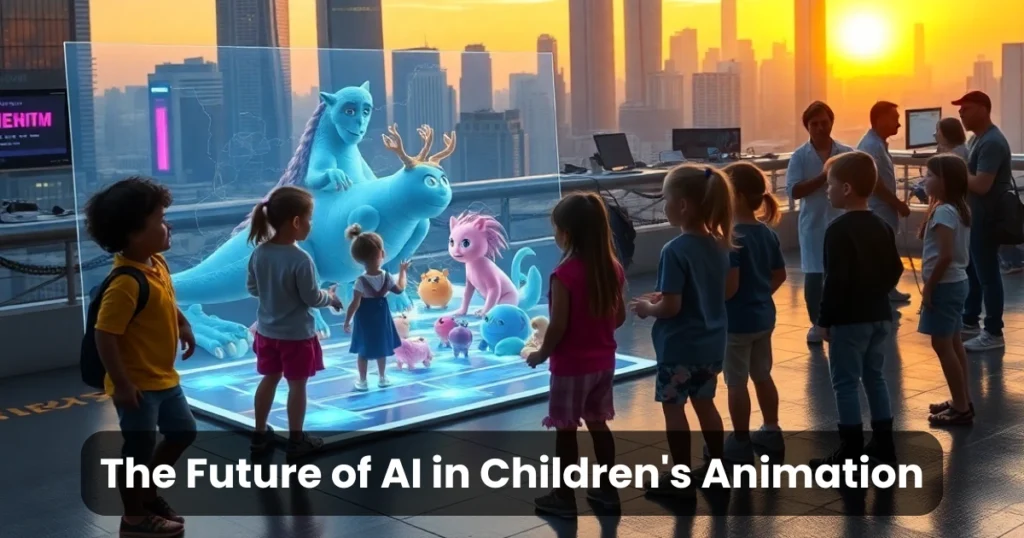
1. Personalized Cartoons for Each Child
AI will soon enable hyper-personalized cartoons tailored to individual children’s learning levels, interests, and languages. Imagine a cartoon where the main character says your child’s name, addresses their favorite topics, and adapts the storyline based on previous episodes watched. This level of customization is already being tested with AI content engines that track engagement and adjust accordingly.
2. Real-Time Interactive Storytelling
In the near future, kids won’t just watch cartoons—they’ll interact with them. AI-driven animation engines will respond to voice commands or choices made by young viewers, creating a choose-your-own-adventure experience. This type of real-time engagement will enhance comprehension, attention span, and critical thinking skills.
3. Multilingual and Culturally Adaptive Content
AI is making it easier to produce cartoons in dozens of languages with accurate localization. This opens up global opportunities, allowing creators to create a kids cartoon with AI that feels native in every culture—down to idioms, visual cues, and even regional music styles.
4. Ethical and Educational Oversight
As AI becomes more involved in children’s media, there will also be a greater emphasis on content safety, ethical standards, and educational value. New AI systems are being trained to automatically filter out inappropriate themes and ensure that content aligns with child development research and pedagogy.
5. AI-Assisted Creativity for Children
Not only will creators benefit from AI, but children themselves may become co-creators. Kid-friendly AI tools will empower young users to design characters, write stories, and animate their own cartoons—fostering digital literacy and creativity from an early age.
6. Faster Production, Higher Quality
AI will continue to reduce production timelines while enhancing visual fidelity, voice realism, and motion fluidity. Small teams—or even individuals—will be able to compete with traditional animation studios, producing professional-quality content at home.
In short, the ability to create a kids cartoon with AI is no longer a futuristic idea—it’s a growing reality that will reshape how children learn, play, and experience stories. As technology becomes more intuitive and responsible, the next generation of children’s animation will be smarter, more interactive, and globally inclusive.
Conclusion
The ability to create a kids cartoon with AI has transformed from a technical challenge into an accessible, creative opportunity for educators, parents, and content creators alike. With the help of intuitive tools, smart automation, and growing personalization features, producing high-quality, child-friendly content is no longer limited to big studios or expert animators.
Whether your goal is to teach, entertain, or inspire, AI empowers you to bring meaningful stories to life in a way that’s fast, affordable, and scalable. By following best practices, addressing common challenges, and embracing the evolving landscape of AI tools, you can craft cartoons that engage young minds and make a lasting impact.
As AI continues to shape the future of animation, those who adopt it early will lead the next wave of innovation in children’s content. So now is the perfect time to take your first step and create a kids cartoon with AI—a fun, fulfilling project that could reach and inspire kids all around the world.


AI Video Ad Creation Guide
Updated on June 24, 2025
Read More